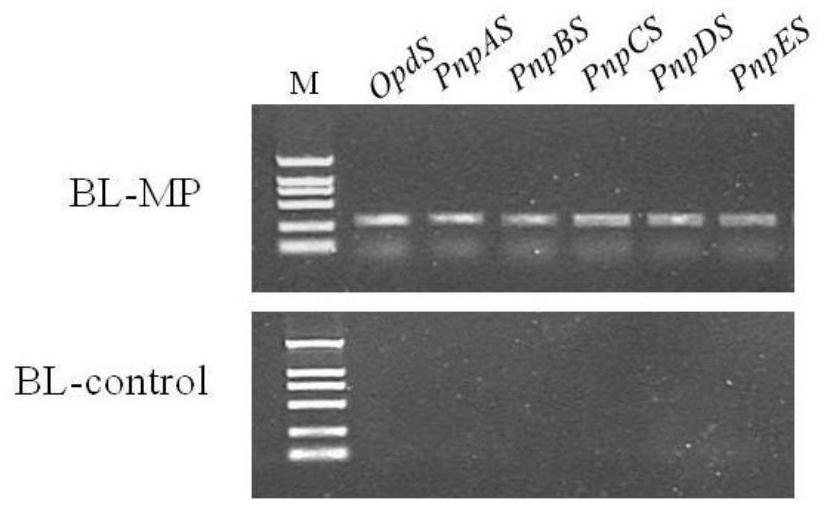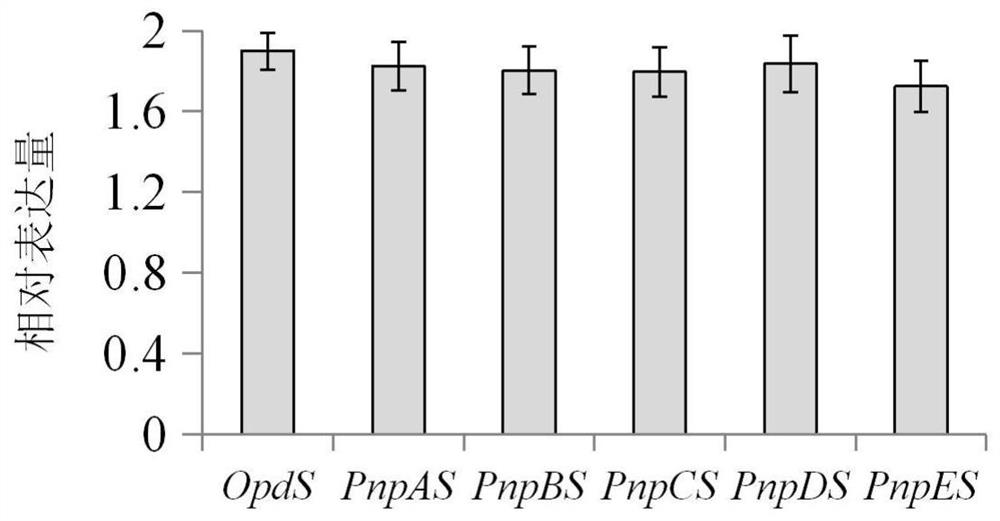Organophosphorus hydrolase genome expressed in escherichia coli and application thereof
A technology of Escherichia coli and hydrolase, which is applied in the field of genetic engineering, can solve the problem of not being able to continue to degrade PNP
- Summary
- Abstract
- Description
- Claims
- Application Information
AI Technical Summary
Problems solved by technology
Method used
Image
Examples
Embodiment 1 6
[0034] The optimized synthesis of embodiment 1 six genes
[0035] Using the Opd gene (GenBank No.AJ421424) of Flavobacterium sp.ATCC 27551 and the PnpA, PnpB, PnpC, PnpD and PnpE genes (GenBankNo.FJ376608.2) of Pseudomonas putida as templates, follow the steps below In principle, the above six segments of genes are optimized: (1) optimize the gene codons, improve gene translation efficiency according to the codon preference of Escherichia coli; Construction of the expression cassette; (3) Eliminate the inverted repeat sequence and stem-loop structure within 100 bp adjacent to the T7 promoter or terminator; (4) Eliminate the inverted repeat sequence and stem-loop structure within 200 bp adjacent to the two genes; ( 5) Eliminate the transcription termination signal, balance the GC / AT inside the gene, and improve the stability of RNA; (6) Make the gene-encoded protein conform to the N-terminal principle to improve the stability of the translated protein; (7) Optimize the secondar...
Embodiment 2
[0038] Example 2 Construction of multigene Escherichia coli transformation vector
[0039] 1. Construction of six gene expression cassette elements
[0040] 1.1 Using the T7 promoter as a template, synthesize the T7 promoter with the DNA sequence shown in SEQ ID NO.7, clone it into a plasmid vector, and determine its sequence by sequencing; use the T7 terminator as a template to synthesize the DNA shown in SEQ ID NO.5 The sequence T7 terminator was cloned into a plasmid vector, and its sequence was determined by sequencing. The synthesis method of the sequence refers to Nucleic Acids Research, 2004, 32(12)e98.
[0041] The splicing of elements was performed according to a modified "overlap extension PCR" technique (Appl Microbiol Biotechnol. 2006, 73(1):234-40).
[0042] 1.2 Construction of OpdS gene expression cassette
[0043] According to the above chemically synthesized T7 promoter, OpdS gene and T7 terminator sequences, design a pair of primers P1F and P1R in tandem. ...
Embodiment 3
[0069] The transformation of embodiment 3 escherichia coli
[0070] 1. Acquisition and identification of transgenic Escherichia coli
[0071] 1.1 Preparation and transformation of Escherichia coli
[0072] 1) Pick a single colony of Escherichia coli and inoculate it in 20 mL of LB medium, and culture it with shaking at 37°C overnight.
[0073] 2) Inoculate 20 mL of LB medium according to the inoculum amount of 1%, and shake and culture at 37° C. at 230 rpm for 3 hours.
[0074] 3) Take 1ml of the culture, put it in ice bath for 30min, centrifuge at 4000r / min at 4°C for 3min, and remove the supernatant.
[0075] 4) Add 500ul of ice-cold 0.1mol / LCaCl 2 solution, resuspend the bacterial pellet, centrifuge at 4,000 r / min for 3 min at 4°C, and discard the supernatant.
[0076] 5) Add 100ul of ice-cold 0.1mol / LCaCl 2 solution, resuspend the bacterial pellet, centrifuge at 4,000 r / min for 3 min at 4°C, and discard the supernatant.
[0077] 6) 50ul volume of ice-cold 0.1mol / LCaC...
PUM
 Login to View More
Login to View More Abstract
Description
Claims
Application Information
 Login to View More
Login to View More - R&D
- Intellectual Property
- Life Sciences
- Materials
- Tech Scout
- Unparalleled Data Quality
- Higher Quality Content
- 60% Fewer Hallucinations
Browse by: Latest US Patents, China's latest patents, Technical Efficacy Thesaurus, Application Domain, Technology Topic, Popular Technical Reports.
© 2025 PatSnap. All rights reserved.Legal|Privacy policy|Modern Slavery Act Transparency Statement|Sitemap|About US| Contact US: help@patsnap.com



